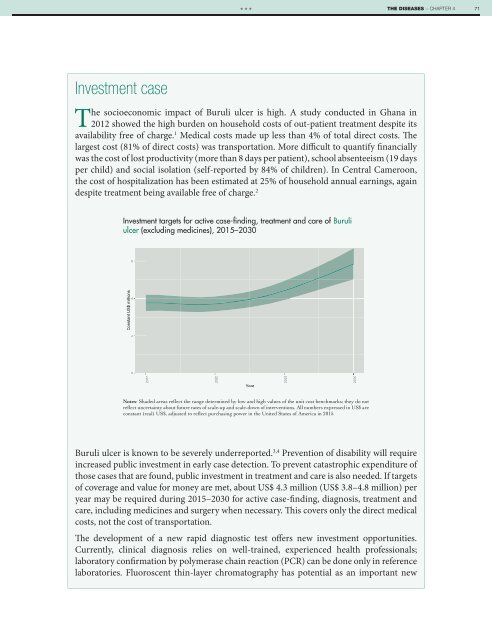1A9bnbK
1A9bnbK
1A9bnbK
Create successful ePaper yourself
Turn your PDF publications into a flip-book with our unique Google optimized e-Paper software.
***<br />
THE DISEASES − CHAPTER 4<br />
71<br />
Investment case<br />
The socioeconomic impact of Buruli ulcer is high. A study conducted in Ghana in<br />
2012 showed the high burden on household costs of out-patient treatment despite its<br />
availability free of charge. 1 Medical costs made up less than 4% of total direct costs. The<br />
largest cost (81% of direct costs) was transportation. More difficult to quantify financially<br />
was the cost of lost productivity (more than 8 days per patient), school absenteeism (19 days<br />
per child) and social isolation (self-reported by 84% of children). In Central Cameroon,<br />
the cost of hospitalization has been estimated at 25% of household annual earnings, again<br />
despite treatment being available free of charge. 2<br />
Investment targets for active case-finding, treatment and care of Buruli<br />
ulcer (excluding medicines), 2015–2030<br />
6<br />
Constant US$ millions<br />
4<br />
2<br />
0<br />
2015<br />
2020<br />
Year<br />
2025<br />
2030<br />
Notes: Shaded areas reflect the range determined by low and high values of the unit cost benchmarks; they do not<br />
reflect uncertainty about future rates of scale-up and scale-down of interventions. All numbers expressed in US$ are<br />
constant (real) US$, adjusted to reflect purchasing power in the United States of America in 2015.<br />
Buruli ulcer is known to be severely underreported. 3,4 Prevention of disability will require<br />
increased public investment in early case detection. To prevent catastrophic expenditure of<br />
those cases that are found, public investment in treatment and care is also needed. If targets<br />
of coverage and value for money are met, about US$ 4.3 million (US$ 3.8–4.8 million) per<br />
year may be required during 2015–2030 for active case-finding, diagnosis, treatment and<br />
care, including medicines and surgery when necessary. This covers only the direct medical<br />
costs, not the cost of transportation.<br />
The development of a new rapid diagnostic test offers new investment opportunities.<br />
Currently, clinical diagnosis relies on well-trained, experienced health professionals;<br />
laboratory confirmation by polymerase chain reaction (PCR) can be done only in reference<br />
laboratories. Fluoroscent thin-layer chromatography has potential as an important new


